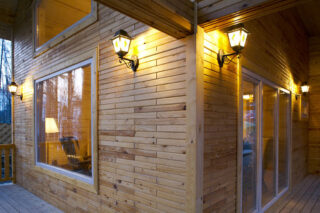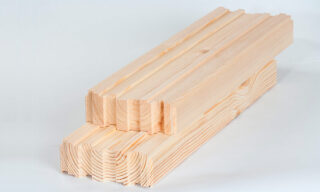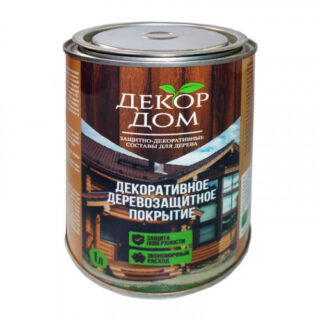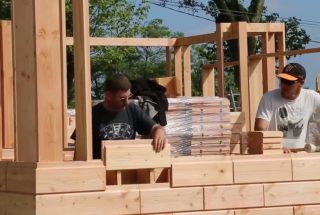The construction of buildings with masonry is one of the most common ways of building a dwelling. Using block elements made from wood is the most sustainable way to make such a house. The material retains heat well and does not emit any compounds harmful to the human body. To build a house of wooden bricks, you need to stock up on specially treated beams.
Features of wood bricks

The material consists of carefully dried rectangular bars of compact dimensions. The proportions of the parts are similar to those of ceramics, and the dimensions may vary. Wooden blocks for building a house are equipped with locks on four sides, which allow fixing the fasteners of adjacent elements to each other. Thanks to this tight fit, the costs of various gaskets and sealing materials are minimized. With the correct installation of wall structures, rainwater does not penetrate into them.
Compared to ceramic products, such material has a much lower weight, which makes it possible not to make a massive foundation and makes it easier to perform work.
Wood bricks are suitable for the construction of residential and country houses and for the creation of utility buildings. The cozy appearance of the material allows you to do without wall decoration inside and outside.
Advantages and disadvantages of the material

Due to thorough drying of raw materials and treatment with an antiseptic, the material is not subjected to deformation effects during operation. It does not crack or shrink. This is achieved due to the low mass of the individual elements. The load is evenly distributed between them, the stress inside the part is minimal. The presence of special gaps in products protects them from deformations associated with temperature extremes.
In buildings made of some other types of materials, the walls may move when there is a large difference in the thermometer readings in the home and on the street.
Also, the advantages of this product include the following features:
- The use of wooden bricks for building a house saves money due to the low weight of the material and the absence of the need for external cladding.
- The lightness of the raw material allows you not to spend money on a massive base. Also, this property simplifies the transportation of raw materials.
- Environmental friendliness of the material: it does not emit harmful chemical compounds. In the production of such a brick from a solid bar, adhesive mixtures are not used.
- Good thermal insulation properties of the material. In addition, the tight fit of the elements allows the installation of wall structures without insulation.
- Simplicity and speed of construction: a house made of such bricks will be ready in one and a half to two months. This is achieved thanks to a technology somewhat similar to the assembly of a constructor. Dense lapping of the grooves allows you to make the wall structure even, without depressions and cracks. Additional reinforcement with galvanized nails increases the reliability of the connection. For their installation, a special tool is used - a pneumatic gun.
- The shape of the elements and their small size make it possible to assemble configurations of different shapes, with a large number of angles and inclined areas.
- When laying products, you do not need to prepare a mortar, sealing and adhesives.

To build a house from wooden blocks, a group of three people will be enough. It is not necessary to invite professional construction crews.
The disadvantage of the material is the need for regular treatment with antiseptic compounds (it is carried out every five years).
When laying walls, it is important to carefully monitor the quality of the joints in order to minimize the likelihood of moisture penetration during the operation of the house. It is also unsafe to install a stove or fireplace in such a building, as the wood can catch fire.
The price of the material cannot be called low, but due to its good performance and savings on cladding and a massive foundation, the total costs will not be too high.
When purchasing bricks, you should make sure that they have been impregnated with antiseptic and flame retardant compounds in production. In the absence of such processing, you need to carry out these procedures yourself or look for another type of product. You can do without any topcoat or use paints and varnishes for this purpose.
Making wooden bricks
The material is made from coniferous timber - both solid and glued. It is made in industrial workshops. It is very difficult to make the same high-quality product on your own.
Pre-workpieces are placed in a drying chamber until its moisture content drops to 10-12%. Then the raw material goes through four-sided and tenoning machines. The result is flat rectangular units of raw materials with chamfers at the corners. They are sent back to the quadrangular machine to form the groove joints.
Sometimes the front side is decorated with a pattern. Then the parts are covered with an antiseptic compound.
Final operations - sorting of products and their subsequent stacking on pallets. In addition to simple smooth bricks, you can find options equipped with a decorative border.
DIY house construction

It is better to build a house from blocks of the same type, made from the same raw materials. The elements are laid out in rows. In this case, each brick must be mounted strictly with an edge on the lock (the opposite option is unacceptable). The first row is laid out from the support bars laid out on the foundation. The configuration consists of two walls, between which bulk or roll heat-insulating material is laid. The easiest option is to use ordinary sawdust for this purpose. But it is also possible to use special sheets of insulation.
An empty space in the overall structure is beneficial in that it makes it possible to hide communications. The outer wall can have a thickness of 30-60 cm. A transverse dressing is arranged every 3 rows. It is made of wood on both sides - external and internal. This structure makes the masonry more reliable and stable. Each row of the dressing should be shifted by half a brick, while it is necessary to avoid coincidences in the vertical plane on the adjacent rows.
Particular attention should be paid to the choice of impregnating compounds and glazes for covering the finished facade. Products with dark shades are not suitable for this purpose. If resin is released from the side of the house, which is more often exposed to direct sunlight, the surface may look unpresentable. It is better to use impregnations with a tone close to the color of the resin.








